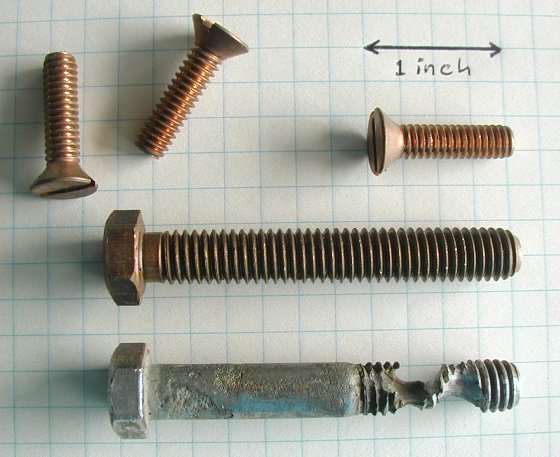Bronze vs. Stainless for Building Boats
Posted by Gayle Brantuk on Nov 1st 2019
by Mark Bronkalla
NOTE: Be sure to get your bronze and stainless fastenings from Glen-L!
Every so often, boatbuilding points out that the correct answer to a problem is not always the obvious one.
There have been many questions regarding which type of fastener is best; whether galvanized, bronze or stainless. This is complicated by the lack of readily available bronze versus the ready availability of stainless.
In a Boatbuilder Forum thread a while back, it was pointed out that stainless will corrode terribly and possibly completely in the absence of oxygen (needed to oxidize and therefore passivate the surface). This did not sit well (not fitting with common sense to me). That coupled with a recent thread on rec.boats.building gave me the drive to find the answer. In addition, over the years I had found a number of bolts and screws that had oddly "necked down". I had blamed this on vibration and mechanical erosion, but with some misgivings since the threads were still present but at a reduced diameter. With further research, a light (finally) went on and I realized what I had seen was the corrosion of the metal.
Stainless steel is "stainless" due to an outer oxide layer forming which resists further corrosion. If the oxide layer is damaged or abraded, then oxygen from the atmosphere will react with the newly exposed metal to form a new oxide layer.
If immersed in liquid containing chlorine or other ions (courtesy of salt water, fresh water impurities, and solutes from the wood itself) in an enclosed space, the metal is attacked. The oxygen becomes depleted from the solution before the other (attacking) ions, and the metal erodes quickly and sometimes completely.

Because of this, bronze is definitely the material of choice below the water line and for through-hull fastenings, whereas stainless may be used above the water line where the joint has a chance to dry out and the oxygen is then replenished. While there are high quality stainless materials available that resist attack, they are not easily found by the amateur whether from a marine supplier or the local hardware store. In addition, they are high cost items.
Galvanized is a lower cost alternative, but you must be careful not to nick or wear through the zinc coating or the steel will corrode anyway. With carriage bolts, the lack of an ability to "trim to fit" is a problem. It is very convenient to be able to buy just a few sizes of bolts and then cut them down to length as needed rather than stocking the many sizes needed, and not having this option is the major downfall of galvanized.
When referring to galvanized, this generally means hot dipped (rough). The galvanized "deck screws" (smooth and shiny) you find at the home center don't count. I recently did some maintenance work on a dock which had been assembled with galvanized deck screws and the majority of them snapped off . Those that did come out were severely rusted and necked down. This is in the upper Midwest with fresh water and cold winters. In a more severe climate (for rusting anyway) I would expect that the dock's deck planks would have lifted right off with little effort.
On my own boat, the through-hull fastenings are bronze to match the castings. This is due as much to matching the materials for minimal electrolytic corrosion as to finding a good deal locally on the bronze bolts. So, in my case, the correct hardware is present on the outside and through the hull. On the inside, I will check the shaft log in the spring as it was fastened down with stainless screws. It is too late now, for this year, as the boat is covered up and we are to get our first significant snowstorm of the year this weekend.
NOTE: Be sure and get your bronze and stainless fastenings from Glen-L!
For further information:
http://www.alberg30.org/maintenance/ruddershoe/
This is a very nice description of the problem with photos.
http://marinesurvey.com/yacht/corrosion_1.htm
This is from Dave Pascoe's site. He is a professional marine surveyor. This site is very helpful for finding out what NOT to do. His explanations are excellent and does not mince words (condemning poor construction). I found it to be very useful to read about what an experienced marine surveyor looks for and then tried to figure out ways to avoid the cited problems. Reading some of his tirades (otherwise known as informed discussions of the lack of quality in modern fiberglass boat construction) will make you feel better about building your own boat versus buying and possibly restoring a fiberglass boat.
http://www.mcnallyinstitute.com/04-html/4-1.html
This also contains a list of metals and relative corrosion resistance.
Google search on: Anaerobic corrosion of Stainless steel
